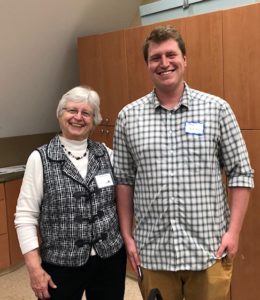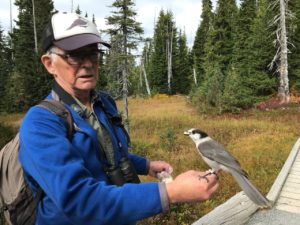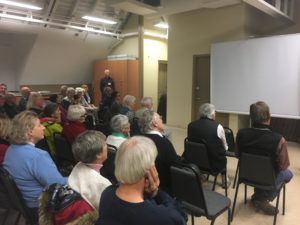Go jays go. That’s what the Orillia Naturalists’ Club was saying when they gathered on November 7th to hear Dan Strickland speak about the distinguished Canada Jay.
Dan Stickland worked as the chief park naturalist of Algonquin Park from 1972 to 2000. He received his Bachelor of Science from University of Toronto then went on to study at the Université de Montréal where he received his Master’s degree. As park naturalist he planned the Visitor Centre and Algonquin Logging Museum and wrote many of the Park’s trail guides and books as well as supervising and training many promising young naturalists. In addition, he and club member Den Vogan played a leading role in establishing “The Friends of Algonquin Park”, a highly successful charitable cooperating association that supports Algonquin Park’s educational programs. Dan has been recognized by both Ontario Nature and the Federal Park Council.
Through his career he studied the Canada Jay and gained insights into its amazing ability to survive on permanent territories in the boreal forests of North America. These birds were once plentiful in Algonquin but very little was understood about them. Banding was the first strategy to begin to understand and track these feisty, intelligent creatures. Key findings include:
• They are not migratory but live in a permanent territory;
• They live for a long time (10-15 years);
• Mortality is highest in the summer (because of migratory birds of prey); and
• Survival depends on food caches that are hidden/wedged into trees in their territory for later winter consumption. (up to 1,000 caches/day in the summer can be hidden for later consumption)
The Canada Jay is a true romantic as courtship feeding begins right around Valentine’s Day and nest building soon after. During their romancing and courtship rituals the female’s body weight increases by 50% in preparation for egg laying. 23 days after hatching the babies fledge and 6 weeks after leaving the nest they are storing their own food. Temperatures are usually well below zero during the nestling period. One of the advantages of this early nesting is avoiding predators like the red squirrel.
Sadly there is a declining population of Canada Jays in Algonquin Park. Probably climate change is to blame. Winter temperatures are increasing and causing increased bacterial degradation of the perishable foods (insects, mushrooms, berries, vertebrate flesh) upon which the jays depend for their winter survival and for feeding their young. In addition, their preferred habitat (black spruce forests) are expected to die out in the south as temperatures warm in the coming decades.
There is no doubt that we are cheering this bird on.
Photos by Matthew Ewing, Marilyn Clark and Jan Rosebush. Text from Cathy Bernatavicius .
 |
 |
| Marilyn Clark -ONC vice president, and Sharon Hancock, have coffee with the speaker Dan Srickland | A grandmother very proud that her grandson has become interested in birding. |
 |
 |
| Dan Strickland on Vancouver Island where he is currently studying a different race of jays | The audience |
